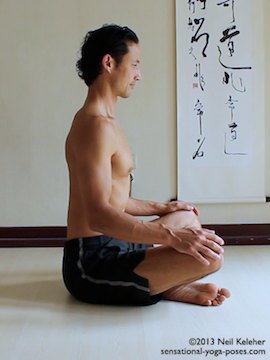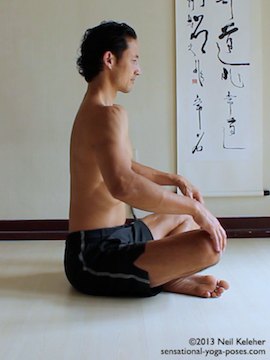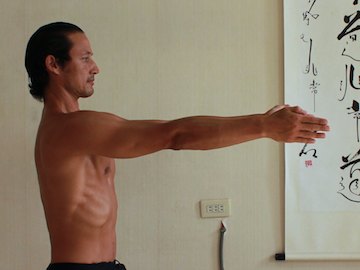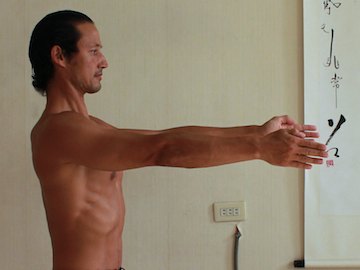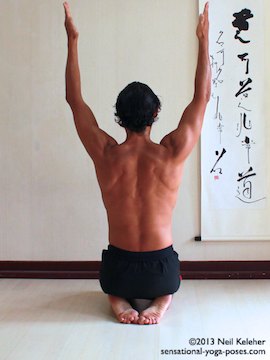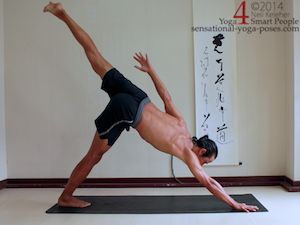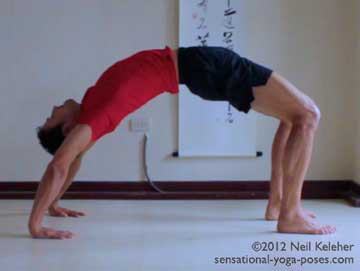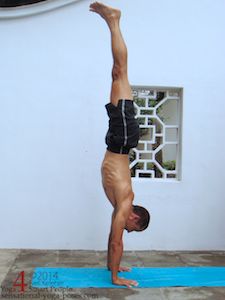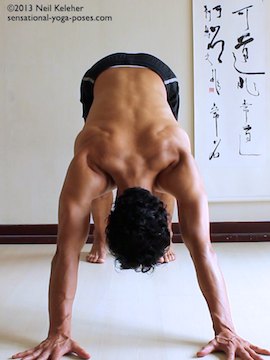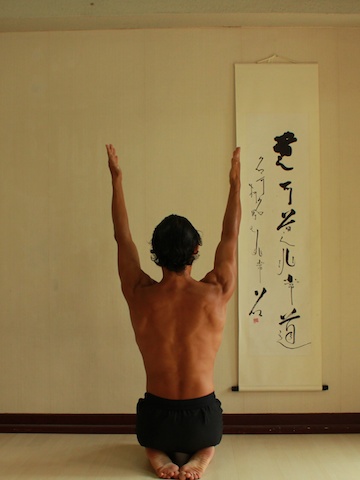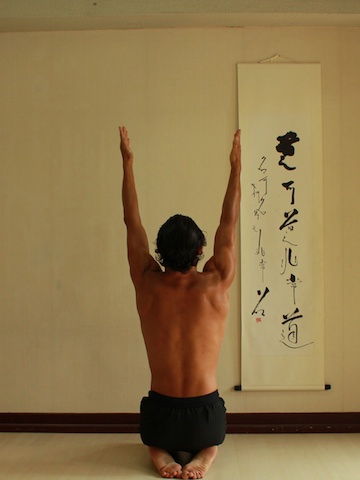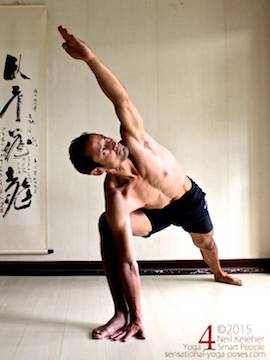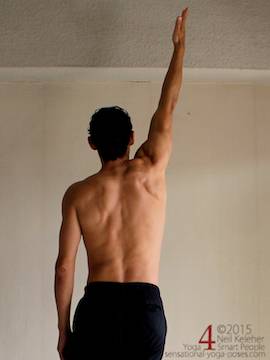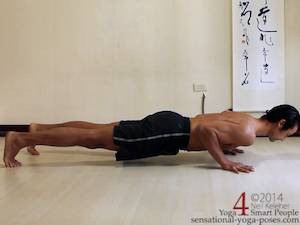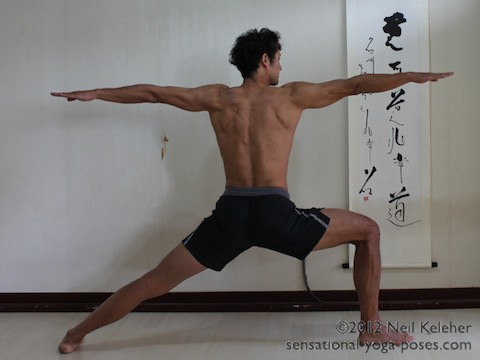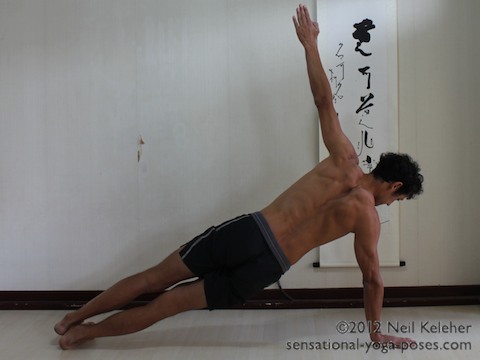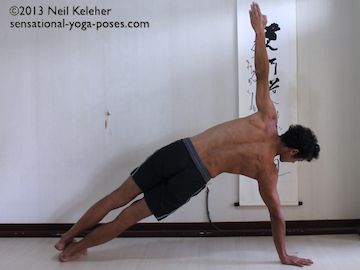Upper Serratus Anterior
From the upper region the upper fibers of the serratus anterior attach to ribs 1 and 2. These fibers may be most important in moving the shoulders outwards when the arm is down (while the torso is upright, either sitting or standing.) They might also be important in Chaturanga type positions (or the low portion of a push up) where the shoulder blades are forced closer together because of the position of the arms.
Middle Serratus Anterior
The fibers from the middle region attach to ribs 3 and 4.
These fibers may help to pull the shoulder blades outwards and also to rotate the scapula upwards.
They may be more active in spreading the shoulder blades (and keeping them spread) when the arm is forwards while standing or sitting upright.
Lower Serratus Anterior
The fibers from the lower region of the inner border of the scapula fan out to attach to ribs 5 through 9 and sometimes to rib 10.
These lowermost fibers may be more active in pulling the bottom tip of the shoulder blade outwards and causing outer edge of the shoulder blade to rotate upwards as the arm is lifted from horizontal to above the head.
Since they operate on the point of the shoulder blade furthest from the shoulder socket, (and because of the larger number of ribs to which they attach) these fibers may have the greatest leverage to help support the shoulder blade in arm lifted forwards or to the sides positions.
These fibers may work with the upper fibers of the trapezius to help support the shoulder blades in "arms over the head" type positions, including those like handstand and downward dog where the arms are supporting the weight of the body.
Ribcage Attachments
Note that the upper fibers attach to possibly the most stable portion of the ribcage, ribs 1 and 2. The middle fibers are also attached to ribs that directly attach to the sternum, ribs 3 and 4. The lower fibers attach for the most part to the floating ribs, though they also attach to the lowest true ribs.
Deliberately Activating Serratus Anterior
To make deliberately activating and relaxing the serratus anterior muscle easier it helps to be able to feel (or be aware of) the inner edges of each shoulder blade since this is where the muscle attaches to them. It also helps to be aware of the sides of the ribs, in particular ribs 1 through 9 since this is where the other end of the muscle attaches. (The dashed line in the picture to the right shows the attachment of serratus anterior muscle to ribs 4 through 8. The solid line shows the inner edge of my right shoulder blade.)
When learning to feel and control any muscle it helps if one end of the target muscle is stabilized. When learning to control the serratus anterior muscle the structure that is easiest to stabilize is the ribcage. However, if an arm is on the floor it may be easier to stabilize the shoulder blade via the arms. (Then you use the serratus anterior to move the ribcage relative to the arm.)
Stabilizing the Ribcage
Generally I teach students how to lift and expand the fronts of the ribs as a precursor to learning to spread the shoulder blades.
Lifting and expanding the fronts of the ribs uses the intercostal muscles. More than likely the external intercostals (whose fibers angle forwards and down from one rib to the rib directly below) but the external obliques, whose muscle fibers are similarly angled (forwards and down from the ribcage to the pelvis) may also help.
So that lifting and expanding the fronts of the ribs is easier it helps to bend the thoracic spine backwards. This action uses the spinal erector muscles. These muscles extend up the back of the body from the pelvis to the base of the skull. They are actually a mass of muscles, each spanning different joints, and so to bend just the thoracic spine backwards the spinal erectors that act just on the thoracic spine activate. (But if you bend both the lumbar spine and thoracic spine backwards, while tilting the pelvis forwards, then the spinal erectors that span both of these sections of the spine will activate.)
Because it can be challenging, especially for newcomers, to hold the ribcage in a bent backwards position, I usually teach them to slowly bend backwards and then to relax. In a seated or even standing position, the weight of the ribs causes the chest to sink when relaxing. If both lifting and relaxing is done smoothly, the action actually turns into a breathing exercise.
Each time the spine is bent backwards and the ribs are lifted the volume of the lungs is naturally expanded, causing an inhale. When the spine is allowed to bend forwards as a result of the ribs sinking down, the volume of the lungs is naturally decreased, causing an exhale. Thus learning to control the spine and ribs can lead to improved breath control. This can be quite handy for students who have difficulty learning to control their breath. It also helps them to become aware of their thoracic spine and ribcage.
Moving the Shoulder Blade(s) Relative to the Ribcage
Back to the serratus anterior. With the ribcage expanded and the thoracic spine bent backwards slightly so that the spaces between the ribs are more open, the serratus anterior muscle has a firm and stable foundation from which to pull forwards on the shoulder blades.
It may now be easier to learn to use the serratus to move the spread the shoulder blades. But first practice moving the shoulders (and feel them moving.) This is to help differentiate the shoulders from the ribcage.
To help differentiate the movements of the ribs and the shoulders:
- First lift and expand the ribs.
- Then move the shoulders forwards.
- Then relax the shoulders.
- Then relax the ribs.
(As part of lifting the ribs, you can also lengthen the back of the neck.)
Relaxing the shoulders from a forwards position tends to cause the shoulders to move back, to a position midway between fully forwards and fully back. This happens because of the way that the shoulders "hang" over the ribcage. Pulling the shoulders forwards tends to cause the top of the shoulder blades to ride over the ribcage. Relaxing the forward pull, the weight of the arms pulling on the shoulder blades pulls the shoulder blades back and down.
To help students who aren't used to feeling their shoulders, or moving them deliberately, another exercise to practice is lifting and lowering the shoulders. This is best done with the neck lengthened since the muscles that act to pull up on the shoulders, the upper trapezius, attaches to the vertebrae of the neck as well as the base of the skull.
Using Serratus Anterior to Spread the Shoulder Blades
Once used to moving the shoulders forwards (and then returning to "center"), the next step is to focus on feeling the inner edges of the shoulder blades. The previous exercise was to get used to moving the shoulders relative to the ribcage. Now, with the focus directed to the inner edges of the shoulder blade, the exercise turns into a serratus anterior muscle activation and deactivation exercise.
The steps are:
- Lift the ribs.
- Spread the inner edges of the shoulder blades.
- Relax the shoulders.
- Relax the ribs.
Why is this exercise different that just moving the shoulders forwards? Because of the awareness involved. Before the focus was on moving the shoulders. Just moving the shoulders forwards may use the pectoralis major muscle. Or the movement can result from tightening the infraspinatus muscle which externally rotates the arm and pulls outwards on the bottom of the shoulder blade at the same time.
Now it is on feeling the inner edges of the shoulder blades. The intent is to help activate the serratus anterior muscle. With a focus on spreading the inner edges of the shoulder blade you are more likely to activate the serratus anterior muscle since that is where it attaches to the shoulder blade. And just to be sure, if you also focus on feeling you pecs at the same time, you can focus on keeping the pecs relaxed as you spread your shoulder blades.
Spreading the Scapulae And Reaching The Arms Forwards
With the arms down by the sides the shoulder blades (or scapulae) move differently than with the arms straight ahead of the body (or up over the head.)
For that reason, once a student or students have gotten the hang of this basic serratus anterior exercise a similar exercise can be practiced with the arms reaching straight ahead. But a precursor exercise is to reach the arms forwards after spreading the scapulae. The steps for this exercise are: Lift the ribs, spread the shoulder blades, reach the arms forwards (keeping the shoulder blades spread). Then lower the arms, relax the shoulders and relax the ribs.
Initially focus on making the steps distinct. Then focus on making the movements more fluid. The feeling is as if spreading the shoulder blades helps to swing the arms forwards.
This set of pictures shows shoulders relaxed, shoulders forwards (using serratus anterior to spread the shoulder blades) and then arms forwards while keeping the "spread" feeling between the shoulder blades. This exercise can also be done while standing.
Spreading The Scapulae with Arms Already Forwards
Another exercise is to start with the arms horizontally to the front.
Keep them there and then lift the ribs and spread the shoulder blades. Then relax both in turn.
You can start with the elbows slightly bent and the fingers slightly relaxed and keep them so while spreading the shoulder blades.
Then vary the exercise. After spreading the shoulder blades then straighten the elbows and then the fingers. Then relax them in turn. When spreading the shoulder blades let the "wave" of the movement straighten the elbows and then the fingers. Relax in the reverse order with the return wave.
In these pictures I'm keeping my arms and fingers straight. The exercise can begin with chest relaxed. Then lift the chest, (first picture) then spread the shoulder blades. Note how in the first picture the curve of my back is interrupted by the inner edge of the shoulder blade and the bulge of the mid trapezius activating.
Dividing the Serratus Anterior Muscle into Three Parts
Recall the three divisions of the serratus anterior.
- The uppermost group extends from the top of the inner edge of the shoulder blade and attaches to the first and second (uppermost two) ribs.
- The middle group extends from the middle section of the inner edge of the shoulder blade (between the top and the bottom as opposed to between the left and right edges) and attaches to ribs 3 and 4.
- The lowermost group extends from the bottom of the inner edge of the shoulder blade and attaches to ribs 5, 6, 7, 8, 9 and sometimes rib 10.
Focusing on the Lower Fibers of the Serratus Anterior Muscle
It would seem that this lowermost set of fibers has the broadest base from which to act. And this may be due to the position of the arms when this set of fibers is most active. This isn't to say that the other sets of fibers (or fascicles) aren't important. It depends on the positions that that the arm is in relative to the body.
With the arms lifted to the front to about eye level the bottom portion of the shoulder blade starts to pull outwards more than the upper portion. This is when the lowest group of fibers may be more active, helping to cause the bottom of the shoulder blade to rotate outwards.
If the arms are slowly lifted forwards and then up to the level of the eyes it may be easier to feel this rotation as the arm moves from being horizontal to an upwards inclined position.
And it may be easier to feel if this is first done one arm at a time.
After spreading the shoulder blade and then lifting the arm forwards to eye level, you can vary the exercise and start with the arms already at eye height. Then, lift the ribs, spread the shoulder blades, and then lengthen your arms. Then relax while keeping the arms lifted.
To play with activating the lower fibers of the serratus anterior muscle a little more you can do the same thing with the arms down by the sides. Try to spread the bottom tip of each shoulder blade. The feeling is like you are trying to pull the bottom tip of the shoulder blade under the armpit, as if holding a purse tucked between the arm and the ribcage. The difficulty is differentiating where the infraspinatus is doing this action or the serratus anterior since the two are quite close to each other in this position.
You may find that it is possible to use the serratus anterior and not the infraspinatus if your rotate the upper arms internally so that the back of the arms move outwards (and the front of the arms inwards.)
Activating the Serratus Anterior with Arms Lifted
The serratus anterior muscle may play a roll in lifting the arms up over the head, or in supporting the shoulder blades when the arms are up over the head, such as in warrior 1, chair pose or the first movement of sun salutation a.
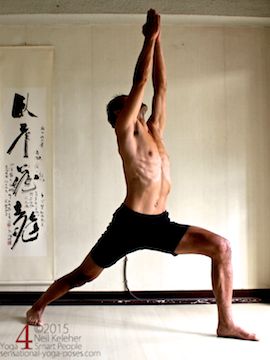
Warrior 1
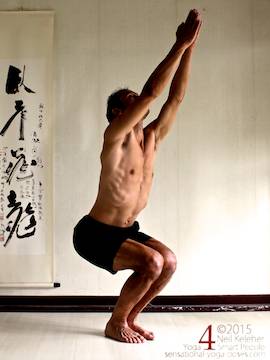
Chair Pose
With the arms lifted up over the head the shoulder blades ideally lift. At the same time the outer edges of the shoulder blades sweep upwards. In addition the shoulder blades as a whole can move outwards, away from the spine. To get the feeling for this, you can practice reaching the arms forwards as before. First lift the ribs, then reach the arms forwards. Then keeping the spread feeling between the shoulder blades, reach the arms up. Then return to the start and repeat.
Another possible exercise for activating the serratus anterior muscle with the arms lifted (but elbows bent) is to start with the shoulder blades slightly retracted (retracted means moving the shoulder blades together.) Then spread the shoulder blades (below right)while keeping the elbows bent.
Using Lower and Upper Trapezius and Serratus Anterior Together
In lifted arm yoga poses or poses where the arms support the body in an overhead position like down dog, wheel pose or handstand the serratus anterior muscle can work in concert with the upper, middle and lower fibers of the trapezius muscle.
The upper fibers of this muscle pull upwards on the outer edge of the scapulae and collar bone. The middle fibers pull inwards on the upper part of the shoulder blade and the lower fibers pull down on the inner edge of the scapulae. (You can see the middle fibers possibly the upper and lower fibers in the bottom right picture below.)
You might also choose to deliberately activate it in inverted yoga poses like pincha mayurasana and handstand.
The upper fibers of the trapezius attach to the accromion process. If you feel the top of one shoulder, this is the bony projection near the outer edge of the top of the shoulder.
The lower fibers of the trapezius attach to the inner angle of the scapulae about 2/3 of the way up the inner edge from the bottom point (or angle).
After practicing the above serratus anterior exercise (with elbows bent) try the same exercise with elbows straight. Widen the inner edges of the shoulder blades away from each other to activate serratus anterior. Then pull upwards on the accromion process. Then try pulling down on the inner border of each shoulder blade.
Side Angle Pose
Using one arm at a time this action can be practiced in a pose like side angle pose. With the left side of the body uppermost, focus on rolling back the right side of the ribcage. At the same time reach the arm away from the pelvis and move the shoulder blade away from the spinal column.
As a precursor to side angle, I'll often have my students practice the same action while standing. The picture shows me with my weight even on both feet. Usually I do this exercise with weight on the same side leg as the lifted arm. Students can then practice making the leg long as well as lifting the same side ribs and shoulder blade. They can also make the arm feel long as well.
Down Dog
To get used to using your serratus anterior muscle while bearing weight in an arms over the head position, you can practice doing downward dog in stages.
Cat Pose and Plank Pose
To get used to using serratus anterior in weight bearing yoga poses with arms forwards, you can practice cat pose and plank.
Chaturanga Dandasana
A slightly more challenging yoga posture for practicing serratus anterior control is Chaturanga.
Supporting the body with the arms, the weight of the body tends to cause the shoulder blades to move towards each other. To counter act this and to help stabilize the shoulder blades at the same time, work at pushing the inner edges of the shoulder blades away from each other.
Activating Serratus Anterior with Arms to the Sides
You can practice activating the serratus with the arms out to the sides in much the same way as with the arms reaching forwards. In the pictures below I'm doing Warrior 2, first with shoulder blades retracted. You can see my middle trapezius activated in order to cause this. In the second picture I'm using my serratus anterior muscle to spread my shoulder blades. With the arms out to the sides the shoulder blades may be slightly closer compared to with the arms over head position. However, the shoulder blades do rotate upwards slightly, indicating that in this position to the lower fibers of the serratus anterior muscle are more active
One criticism of my posture in the above two pictures (not including the messy hair) is that I could do more to lengthen the back of my neck.
The same serratus anterior muscle action can be used in the yoga pose called side plank. With one arm supporting the body, if the serratus anterior is relaxed the ribcage sinks down towards the supporting hand (first picture.) With serratus anterior active, it pushes the ribcage up away from the hand.
In the second picture above, serratus anterior activated, my torso is bent towards the supporting hand. I tried to do the pose with my torso straight, in line with my legs, but found that then it was more difficult to move my ribcage relative to the supporting arm shoulder blade.
It would seem then that in order to activate the serratus anterior, (at least for me, and at least on the day that I took these photos) the shape of the ribcage and spine can affect ones ability to activate serratus anterior. So in plank pose, bend towards the supporting arm side. (If right arm is supporting the body, then bend the spine to the right.) Or if you like, focus on pushing your pelvis up away from the floor and opening the uppermost side of the ribcage.
For more on Shoulder Awareness
Check out my
Yoga for Your Shoulders course
Published: 2020 08 28

